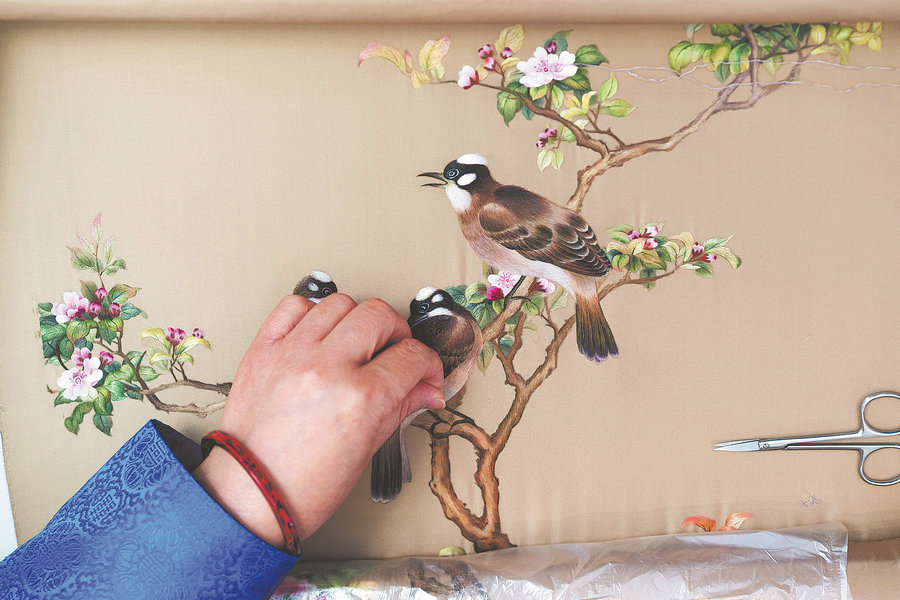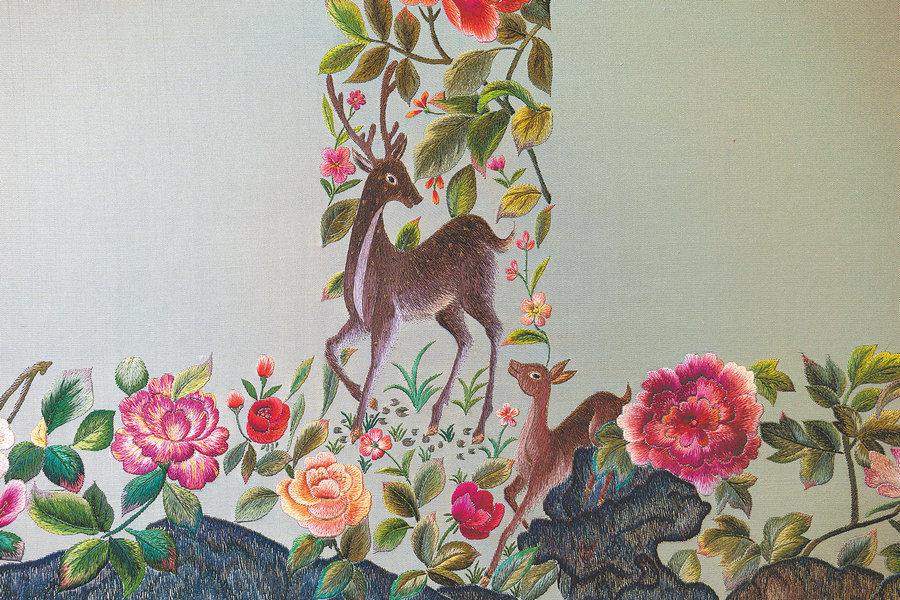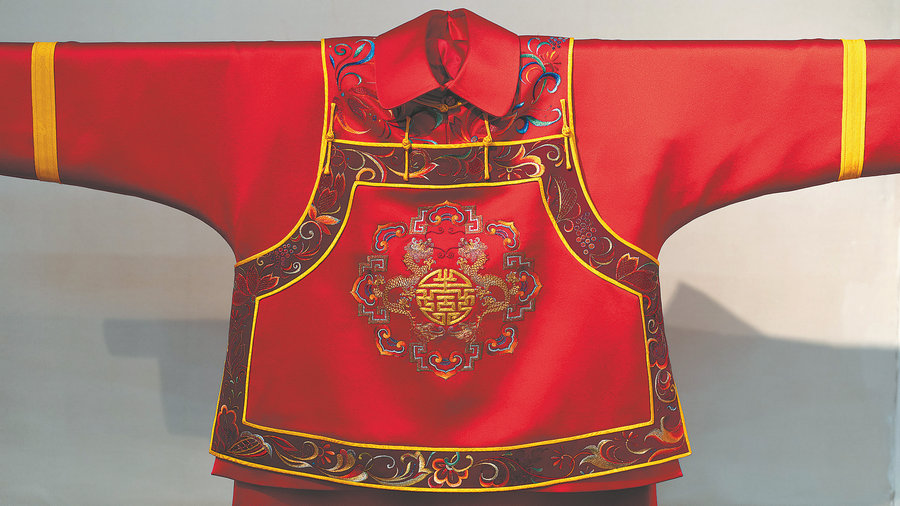Following the patterns of history
Editor's note: Traditional arts and crafts are supreme samples of Chinese cultural heritage. China Daily is running this series to show how master artisans are using dedication and innovation to inject new life into these age-old heritages. In this installment, we follow the thread of history from ancient Suzhou to discover how skilled embroiderers are helping their craft evolve to fit modern Chinese lifestyles.
"Only when I take the needle out and touch the silk thread, I feel fully comfortable," says Zou Yingzi, an inheritor of Su embroidery, an ancient craft that originates from the garden city of Suzhou in Jiangsu province.
The day before the interview, the 53-year-old worked more than 10 hours, until late into the night, on a large piece of Su embroidery. A piece measuring around half a meter can take her months to complete.
From Zou's mother to her grandmothers, all the women in her family are good at needlework, particularly Su embroidery, which features intricate stitches and the creative use of silk threads dyed in various colors.
She remembers that just a few days after her mother had surgery, the woman in her 70s jumped out of her bed and sat in front of her embroidery frame, telling others not to disturb her to encourage her to rest.
"We thought she was working, but she regarded embroidery as her way of relaxing. That's what Su embroidery means to us. The needle is our paint brush, while silk threads are the paint. We can express our ideas and emotions on fabric and, in doing so, find peace in mind," says Zou.
Su embroidery has a history of more than 2,000 years. A piece of fabric with exquisite silk embroidery unearthed from a tomb in the area showed that the craft dates back to the Spring and Autumn Period (770-476 BC). Since ancient times, needlework had been a must-learn skill for women, who had to make clothes for their families. It was a tradition that mothers should make wedding clothes with exquisite embroidery for their daughters.
Zou recalls that, when she was little, her grandmother was busy every day, making wedding clothes and quilts for granddaughters. At the age of 6, she started to help her mother to make Su embroidery items, all of which were sold to support the family.
"I had a dream to become a painter. Now, the needle helps me to realize that dream," says Zou.
Her studio in Suzhou is full of her work. Flowers, cats, butterflies, figurines of Buddhist deities and scenes from nature become vivid and real on silk fabric. Viewers can even make out a single strand of a cat's fur. A single silk thread can be split into 16 or more strands, which in most cases are too thin to be seen. The studio provides magnifying glasses for visitors to better appreciate the details of Zou's work.
"Su embroidery has enchanted me for decades. I can work for days without sleep to make a fine piece," says Zou.

A signature work by Zou Yingzi. [Photo by Gao Erqiang/China Daily]
Courting royalty
Su embroidery is known for its rich colors, intricate embroidery techniques, elegant designs and clean stitches. All these characteristics, which distinguish it from other embroidery styles in China, have been long closely connected with the natural environment and lifestyle of Suzhou, a city that has a long history of silk production and textile craftsmanship, making it a natural hub for the development of embroidery techniques, according to Zheng Lihong, an art professor of Soochow University.
Suzhou also boasts elegant gardens and Kunqu Opera. It has been an economic and cultural center in ancient China for a millennium. Many noblemen and well-educated people settled down in the city. Women from these rich and noble families had a good taste for art. The style of their needlework was influenced by the aesthetic tastes of the city's nobles.
"To some extent, Su embroidery is close to paintings. Many artists offered their ink paintings and calligraphy for embroiderers to re-create," says Zheng.
Zheng adds that centuries ago, the number of female painters in and around Suzhou reached more than 200. The rich cultural and artistic environment gave Su embroidery a high level of aesthetic expression.
The embroidery in Suzhou reached its golden age during the Song Dynasty (960-1279), incorporating elements of the literati paintings that were popular at the time. The craft became a favorite in the court of the Qing Dynasty (1644-1911) and was used in the tailoring of robes and decorations coveted by Chinese royalty. It was during this period that the name "Su embroidery "was first coined.
"It is an art form created by women who live in a city that boasts an artistic lifestyle," says Zheng.
In 1954, the Suzhou Silk Embroidery Research Institute was established, and many innovations in silk embroidery techniques soon followed. Products made using Su embroidery were among the most popular handicrafts exported overseas.
Embroiderer Zou remembers that, in the 1980s and '90s, she and her mother made lots of Su embroidery items to be sold overseas — Japan, South Korea and Europe — to earn money. But her father encouraged her to stitch for the sake of art. At the age of 19, Zou learned how to paint, and spent months learning other embroidery techniques from an established embroiderer.
Now, she is able to proficiently apply various stitching techniques to different parts of her creations. Techniques to stitch a cat's eyeball, its hair and its tail are different.
"Su embroidery has very flexible stitching techniques. It varies based on the picture we make," says Zou, whose works are now widely collected by museums in China.

Fu instructs an embroiderer at her studio in Suzhou, Jiangsu province. [Photo by Gao Erqiang/China Daily]
A human touch
Unlike Zou, whose works are more like art pieces, embroiderer Fu Xianghong's products are often made for everyday use.
Sitting in her studio in Suzhou, where large-size embroidery pieces of flowers, birds and animals hang on walls, the 59-year-old says that, for her, Su embroidery is a kind of art that decorates life. Exquisite silk cellphone bags, fan bags, clothes with Su embroidery patterns, accessories, floor screens, and even furniture, are among her range of products.
She has an exhibition hall to showcase the wedding clothes made for her daughter and grandchildren. The garments, with their exquisite and elaborate needlework, took her several years to finish and have won her lots of praise.
"For me, clothes are just one kind of medium to showcase Su embroidery, the only interest and passion in my life," says Fu.

A flock of birds come alive in the skilled hands of Fu Xianghong, 59, a master of Su embroidery known for her flower-and-bird works. [Photo by Gao Erqiang/China Daily]
Like other embroiderers, Fu learned the technique from her family. The needle was her favorite childhood toy.
"Almost all the women then could do needlework. It was common for families to raise silkworms and work in family-run embroidery workshops. Many women earned more money than their husbands," says Fu.
She proudly shows a large-size embroidery of flowers made by her mother, and another exquisite piece, featuring plum trees and flowers, made by her aunt, both of whom made their respective works while in their 70s.
"My mother and my aunt are just two of thousands of ordinary embroiderers in Suzhou. They kept practicing Su embroidery until the end of their lives. The craft is ingrained in our blood," says Fu.

Animals and flowers are iconic subjects in the works of Fu Xianghong. [Photo by Gao Erqiang/China Daily]
The usual subjects of Su embroidery include landscapes, calligraphy, flowers, birds and insects, cats, and Buddhist deities. Fu, born in a village in a mountainous area, where flowers can be seen all year round, is good at creating flower-themed works.
To produce vivid flowers, Fu goes outside to observe her subject closely, but most of her time is spent at her studio, where she can sit down and stitch for hours, sometimes getting so engrossed she forgets to eat and sleep.
To re-create the colors of the flowers, she must stitch the key parts of her pictures during the day, because natural light is important for creating Su embroidery due to the abundant colors. For a single color, like blue, Fu has to dye dozens of shades of blue. Different parts of a flower also need threads of various thickness.
"Behind the beauty of Su embroidery are lots of intricate processes. The charm of the art is its highly flexible and innovative use of stitching techniques," says Fu.
Thanks to the development of the craft, the number of Su embroidery techniques has risen from about 10 initially, to dozens today.
Fu says her work cannot be replaced by machines or AI, because of creativity and innovation it requires. The charm of Su embroidery is the trace of a human touch.

A wedding garment made by Fu Xianghong for her grandchild. It was a tradition that mothers should make wedding clothes with exquisite embroidery for their daughters. [Photo by Gao Erqiang/China Daily]
As time goes on, Fu's passion for the craft only increases, and it is now more of an artistic expression rather than just a way to earn money. However, a long time spent scrutinizing fine details has affected her eyesight, and made her slower compared to her peak production as a younger woman.
She has a team of about 20 women, who are all experienced embroiderers. Her daughter is also following in her footsteps.
"For me, Su embroidery is not art confined to museums. I prefer to connect it with our everyday lives and make it more suitable for our modern lifestyle," Fu says, pointing to her daughter nearby who wears a silk bag, a coat and a necklace all adorned with Su embroidery patterns.
Photos
Related Stories
- Trending in China | Elegance and style of Chinese-style purse
- Women of Yao ethnic group showcase embroidery skills in S China's Guangxi
- In pics: Artistry of Xiamen glass bead embroidery
- Talented male embroiderer promotes Uygur embroidery, leads fellow villagers to prosperity
- Qianxi in SW China's Guizhou cultivates big Miao embroidery industry
- Costume contest festival of the Yi people: A platform to promote, celebrate the art of embroidery
Copyright © 2024 People's Daily Online. All Rights Reserved.









